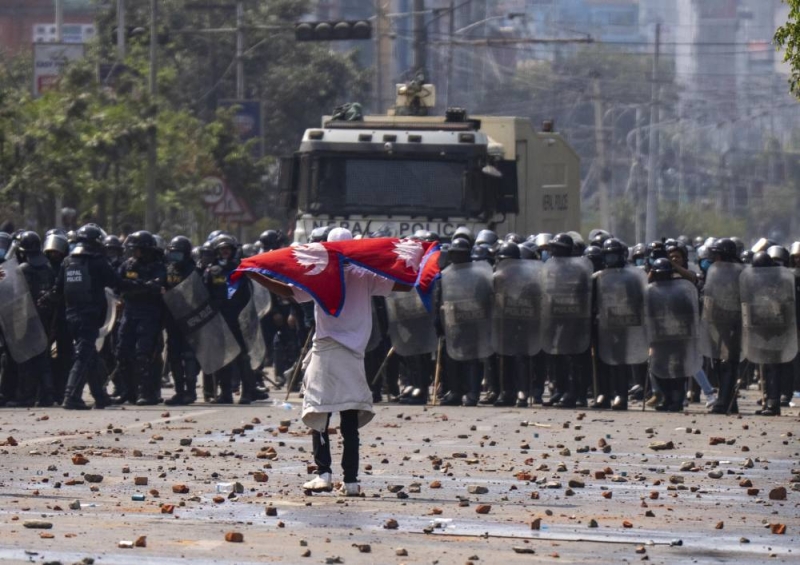The capital city has been slowly recovering from a virtual seismic shock that it received from the Tin Kune violent demonstration leading to the demise of two persons and injury to several persons. Though the organisers of the demonstration had reportedly assured it would be peaceful, the protest took an ugly turn with the stoning, arson and looting of not only the buildings adjoining the demonstration site but also nearby Kantipur and Annapurna media houses together with a far-off Herbal Processing Centre and Koteswore Supermarket. The police had stated that they had to resort to firing after the commander of the demonstration, Durga Prasain, drove recklessly into the police gathering threatening to run over them.
The demonstrators on the other hand have maintained that the crowd became uncontrollable after they were attacked with tear gas shells while singing the national anthem at the beginning of the programme. The government has arrested senior leaders and volunteers of the Rastriya Prajatantra Party (RPP), and it is going ahead with the necessary investigation towards punishing the culprits. However, demands have been made from several quarters, such as lawmakers and the human rights organisations, to form an Independent Judicial Inquiry.

It has now become clear that the police used more force than necessary. The use of outdated tear shells, the unwarranted use of bullets, instead of water cannons, and rubber bullets, and the failure of the security forces to reach the other sites despite requests have exposed the failure in addressing the riot. Moreover, the government has defended the security mechanism with the flimsy argument that it was not prepared for such a violent incident in view of the assurance given by the organisers.
The government has naturally lost the faith of the people, opening a window for the formation of an Independent Judicial Inquiry. The creation of an independent inquiry has been underway since time immemorial, albeit in different guises. When a washerman refused to accept his spouse after she had been away for a night saying that he was not like Rama who had done otherwise despite Sita being hijacked by Ravan for days together, Sita had to undergo a fire ordeal.
The fire did not burn her proving her probity of character. In the Mahabharata, Dronacharya, the Guru of the Pandavs as well as Kauravs – upon hearing from Bhim that he had killed his son Aswasthama when he had actually killed an elephant by the same name on the advice of Krishna – wanted to hear from Yudhisthir, the truth speaking icon, whether his son was really dead. Yudhisthir said, "naro ba kunjaroba, aswasthama hoto hata," meaning either a person or elephant, Aswasthama was dead.
Krishna blew the conch so loudly when Yudhisthir said either a person or elephant that Dronacharya only heard Aswasthama was dead. Dronacharya withdrew from the war and sat down in meditation, and in the meantime, he was killed by Dristidhyumna, the commander of the Padavas in the war. If this is the case of mythic times, in the historic as well as modern times also such commissions have been set up.
In the West, the first general inquiries statute enacted by British legislation is found in Chapter 38 of the 1846 Statutes of the Province of Canada. That same year a meeting of the State Council was held by Junga Bahadur after the Kot Massacre. Consequently, the queen, Laxmidevi, was banished to Benaras after being allegedly guilty of several charges.
It can be seen that this British tradition entered India and later spilled into Nepal as well. Consequently, the Commission of Inquiry Act, 1969 was enacted during the regime of King Mahendra. The first commission was headed by Justice Bhagwati Prasad Singh which recommended that the Anglo-American approach was appropriate for Nepal's criminal justice system.
According to a report published by the International Commission of Jurists, some 38 such commissions were formed in two decades of the democratic era starting in 1990. The first one was a one-man committee constituted in 1990 and the 38th in 2010 under the Chairmanship of Ballabh Shumsher Junga Bahadur Rana and Gehenath Bhandari, respectively. A fleeting glance at these commissions reveals that they have at the best defused the crisis and promoted impunity if studied properly.
The commission, if set up now, will also meet a similar fate as that of the Khila Raj Regmi Commission which was formed to inquire into the conflagration and looting of public and private property during the unrest instigated by the Madhesi Jana Adhikar Forum in May 2007. The report was submitted, but no action was taken. In view of this harsh reality, the creation of a commission may not solve the present problem.
Theoretically, it may appear rosy, but it is not without thorns. The need of the hour is thus to go for national reconciliation in view of the country facing a national crisis. The Republicans and the royalists should follow a middle path instead of maintaining extreme positions.
The middle path could be the holding of a referendum to choose among the Republican Hindu state, a Hindu kingdom and secularism. This can be done free of cost as the election of the local government has to be held in 2084 BS in view of its support by all the political parties unlike their differing views of the provincial government. This is possible with the support of a two-thirds majority that the Nepali Congress and the Unified Marxist-Leninist enjoy in the Parliament.
These two parties should exhibit a big heart rather than be parochial in the present circumstance. Republicans and particularly Monarchists lately have been claiming huge people's support. The referendum will also expose the solidity or the hollowness of the claim.
.
Politics

Formation of an independent Judicial Enquiry: Theory and practice

The capital city has been slowly recovering from a virtual seismic shock that it received from the Tin Kune violent demonstration leading to the demise of two persons and injury to...















